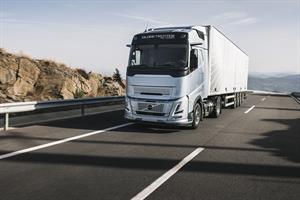The safety of the trucks on European roads is in the spotlight after Euro NCAP, (the European consumer test organisation) revealed the first set of results for its brand-new TRUCK SAFE assessment programme recently.
 This is the first time that HGVs have been tested for safety. Out of nine trucks assessed, Volvo’s FH Aero and FM models both earned a maximum five-star rating, while IVECO’s current S-WAY model emerged as the weakest performer with one star.
This is the first time that HGVs have been tested for safety. Out of nine trucks assessed, Volvo’s FH Aero and FM models both earned a maximum five-star rating, while IVECO’s current S-WAY model emerged as the weakest performer with one star.
As part of its mission to achieve Vision Zero (eliminating all traffic fatalities and serious injuries), Euro NCAP has turned its testing and safety performance attention to the HGV vehicle category for the first time.
The testing protocols
The first cohort to be tested under the TRUCK SAFE protocols were nine trucks from the fleet long-haul segment. The nine trucks selected for testing represent 95% of the trucks in this category that are currently on Europe’s roads.
TRUCK SAFE is the first of Euro NCAP’s testing protocols to adopt a new framework that measures vehicle safety across the lifecycle of an accident. For this particular assessment of long-haul HGVs, the evaluation methodology ‘the Stages of Safety’ focusses on three stages and the timeline of a typical accident scenario: the hours and minutes before an accident with an emphasis on safe driving; active safety system intervention before an incident or crash avoidance; and the post-crash ‘golden hour’ after an incident. A percentage score is awarded for performance during each stage. These scores are then collated to determine an overall rating out of five stars.
Trucks were evaluated at various Euro NCAP-accredited testing facilities across Europe, including HORIBA MIRA in the UK, Applus IDIADA in Spain, DEKRA in Germany, and CSI in Italy.
The results
Of the nine trucks evaluated, two achieved a five-star rating (Volvo FH Aero, Volvo FM), two were awarded four stars (Renault Trucks T, Scania G-series), four earned three stars (DAF XF, MAN TGX, Mercedes-Benz Actros L, Scania R-series) and one scored a single star (IVECO S-Way). Four trucks were also awarded the CitySafe accreditation.
“This outstanding result makes me so proud as it confirms Volvo Trucks’ leading position in safety,” said Roger Alm, President Volvo Trucks. He continued: “Safety is a core value for us and a cornerstone in our heritage. Safety has been guiding us from the very start of our company – and with every new product launch we are making our trucks even safer.”
“This is proof of our consistent efforts in safety developments to go beyond what is required by legislation, towards our vision of zero accidents involving our trucks”, said Anna Wrige Berling, Traffic and Product Safety Director, Volvo Trucks.
“This testing shows there is a big difference between the relative safety of current truck models,” said Matthew Avery, Director of Strategic Development, Euro NCAP. “It’s worth noting the differences we’re seeing are down to manufacturers’ current safety strategies. That means these results provide a strong snapshot of the HGV market before Euro NCAP influences the safety of vehicles. The results show that there are plenty of safety features available in the market and not necessarily just with more expensive models. For instance, Renault, that achieved four stars, is positioned towards the less expensive end of the market. And likewise, there’s a big question over who makes the safest truck. I think it’s interesting that Volvo, without any motivation from Euro NCAP, has produced a truck that’s done really, really well and represents real safety gains on European roads. Volvo has the technologies that are going to address most of the crashes that account for the 3,000 or so people that are killed every year on Europe’s roads.”
“The launch of our TRUCK SAFE assessment programme is a landmark moment for vehicle safety and marks the start of our journey into fleet and business purchases,” said Dr Michiel van Ratingen, Secretary General Euro NCAP. “This is an essential step towards achieving Vision Zero. Our first set of TRUCK SAFE testing protocols do a fantastic job of assessing capability and identifying which manufacturers are performing well. In due course, we will add passive safety (collision protection) by 2030 to further address the problems of truck-to-car crashes. As well as inspiring manufacturers to build safer trucks, TRUCK SAFE will also unite everyone within the HGV safety ecosystem for the first time. These stakeholders have a lot to gain from having safer trucks on Europe’s roads, whether that’s road authorities being able to reduce the societal cost of road transport and supporting a growing economy, freight shippers minimising their reputational risk and protecting their brand, or helping manufacturers to build safer trucks that will be more attractive to the market. It’s a well-known fact that a safe truck is a more profitable vehicle, and that’s something that benefits business and Europe as a whole.”
The next batch of TRUCK SAFE results will focus on the long-haul fleet rigid segment and will be released in April 2025. The urban distribution segment will then come under scrutiny, with those results set to be revealed in October 2025.
Photo: Volvo FH Aero.